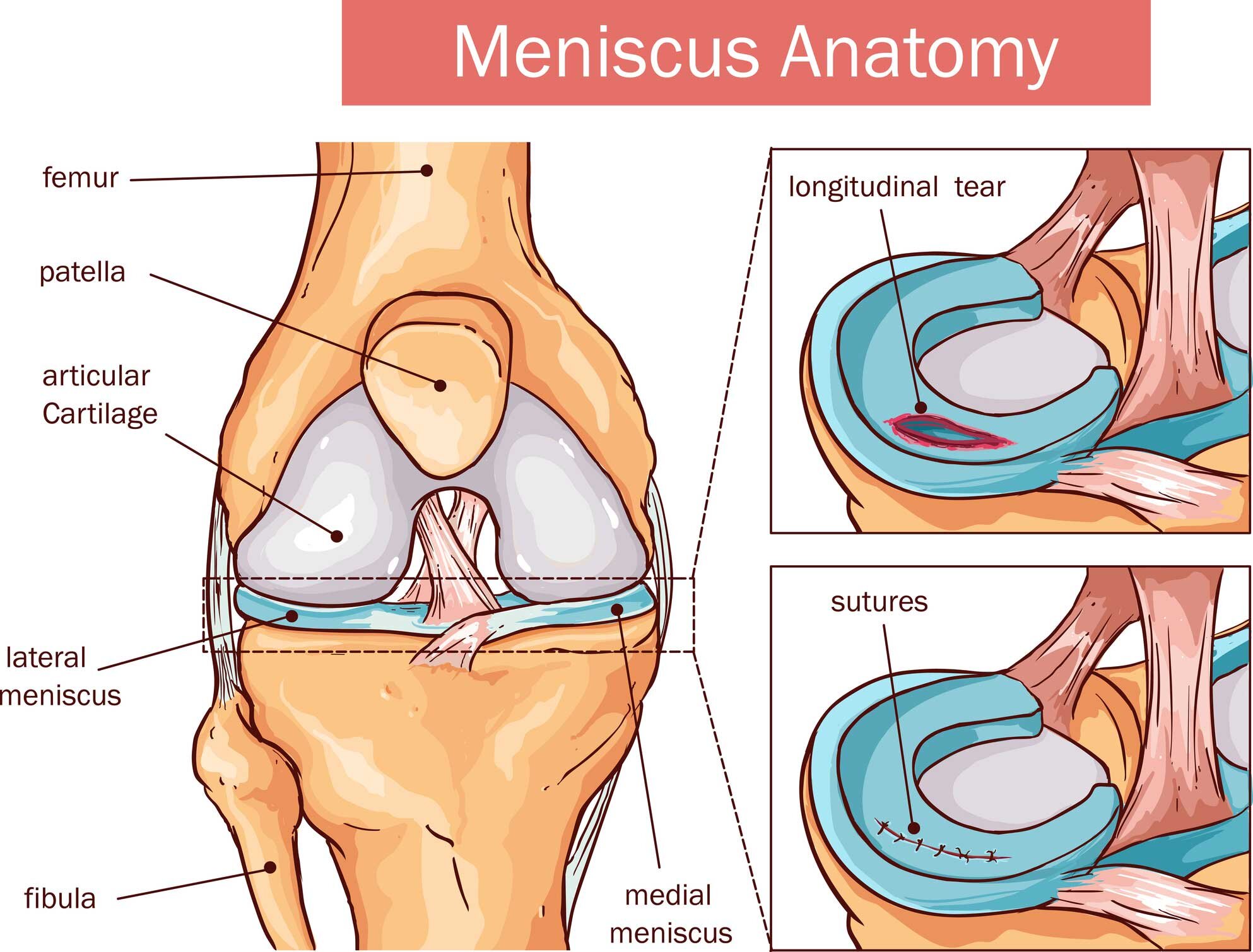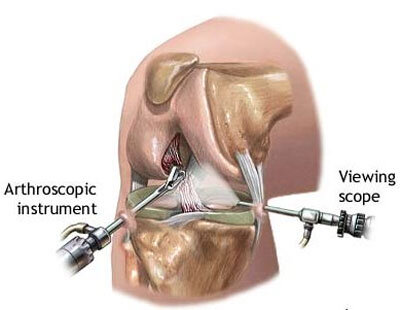Knee Meniscus Surgeries
A torn meniscus is damage from a tear in the cartilage that is positioned on top of the tibia to allows the femur to glide when the knee joint moves. Tears are usually described by where they are located anatomically in the C shape and by their appearance (for example, "bucket handle" tear, longitudinal, parrot beak, and transverse). While physical examination may predict whether it is the medial or lateral meniscus that is damaged, a diagnostic procedure, like an MRI or arthroscopic surgery, can locate the specific part of the cartilage anatomy that is torn and its appearance.
Because the blood supply is different to each part of the meniscus, knowing where the tear is located may help decide how easily an injury might heal (with or without surgery). The better the blood supply, the better the potential for recovery. The outside rim of cartilage has better blood supply than the central part of the "C." Blood supply to knee cartilage also decreases with age, and up to 20% of normal blood supply is lost by age 40.
At Aptiva Health, we offer same-day and walk-in appointments for knee injuries and conditions to evaluate, diagnose, and make the appropriate referral for additional treatment based upon your specific knee injury or condition. We treat these conditions in our General Medicine, Orthopedics, Sports Medicine, Pain Management, and Physical Therapy departments.
Shown above are six common types of meniscus tears.
Intrasubstance/Incomplete Tear: An intrasubstance tear is a common finding on an MRI report. Seen in the upper left corner of the image, an intrasubstance tear typically looks normal at the time of surgery. Often these are a sign of early degenerative changes of the meniscus tissue, but seldom are they the sign of a problem. Incomplete and intrasubstance tears of the meniscus are stable injuries, and they generally do not require any surgical treatment. By the time people are in their 20s or 30s, intrasubstance changes of the meniscus tissue are very commonly seen on an MRI.
Radial Tear: Radial tears of the meniscus, pictured in the middle of the top row on the image, are the most common type of meniscus tear. These tears are within the avascular zone of the meniscus, where there is no blood supply, and therefore there is little capacity for these tears to heal. Therefore, when these tears come to requiring surgical treatment, typically the only option is to trim out the damaged portion of the meniscus.
Horizontal Tear: A horizontal tear is a tear that is most commonly amenable to meniscus repair. Seen in the upper right corner of the image, a horizontal tear runs along the circumferential fibers of the meniscus. Rather than removing the damaged portion of the meniscus, a horizontal tear may be able to be sewn together.6 The key to determining the treatment of these tears is their location. If located within the vascular portion of the meniscus (near the outer edge) then there is healing potential, and thus repair. When located more centrally, these tears will not heal, even if repaired.
Flap Tear: A flap tear of the meniscus, pictured in the bottom right corner of the image, is an unusual pattern of the tear. In circumstances where the flap is causing symptoms of catching in the knee, usually, the flap of the meniscus can simply be removed without removing much tissue at all.
Complex Tear: A complex tear means there is a combination of tear patterns. Shown in the middle image on the bottom row, a complex tear often involves both radial and horizontal tear patterns. Typically complex tears are not treated with meniscus repair because of the complex nature of the tear. In some unusual circumstances, some of the torn meniscus can be removed, while other portions can be repaired.
Bucket-Handle Tear: A bucket-handle tear is a large type of horizontal tear of the meniscus. These tears often cause the knee to become stuck by causing the torn portion of the meniscus to block normal knee motion. Bucket-handle tears often require more urgent surgical treatment in order to allow the knee to start bending again.
Meniscus repairs are done arthroscopically. This means your doctor will make small cuts in your knee. They’ll insert an arthroscope to get a good look at the tear. Then they’ll place small devices that look like darts along the tear to stitch it up. Your body will absorb these over time. The two main arthroscopic meniscus repair surgeries are:
Arthroscopic partial meniscectomy. Your doctor will remove a piece of the torn meniscus so your knee can function normally.
Arthroscopic total meniscectomy. During this procedure, your doctor will remove the whole meniscus.
Meniscal transplant surgery
Meniscal transplant surgery is a type of surgery that replaces your missing or damaged meniscus with a meniscus from a cadaver donor. The surgery usually takes place under general anesthesia.
Your knee has 2 wedge-shaped pieces of cartilage, 1 on each side of your knee. Each one of these pieces is called a “meniscus.” These 2 rubbery menisci act as shock absorbers between your thighbone (femur) and your shinbone (tibia). A different type of cartilage capping the tibia and femur also helps your bones move smoothly. These 2 menisci help protect the ends of your femur and tibia as they move together.
Sometimes, a twisting injury may severely damage your meniscus. If the damage is severe enough, your surgeon may need to remove your meniscus. Without this meniscus cushion, the ends of your tibia and femur may start to rub together abnormally. Over time, this can cause persistent knee pain. Eventually, it may cause arthritis. Your cartilage “cap” degrades and the bones beneath start to scrape together.
Meniscal transplant surgery provides another choice for you.
Meniscal transplant surgery might make sense for you if your meniscus was removed in a previous surgery. Without a meniscus, you might gradually develop knee pain and arthritis of your joint. Replacing your meniscus may provide significant pain relief. It may also help prevent arthritis in your joint. This can develop when your cartilage becomes frayed and rough. This surgery is less invasive than knee replacement surgery.
You might be a good candidate for meniscal transplant surgery if the following apply to you:
You’re younger than age 55.
You’re missing more than half your meniscus, or you have a large meniscus tear that is irreparable.
You have significant or persistent pain with activity, or you have an unstable knee.
You have only minimal arthritis, or none at all.
You have a knee with normal alignment and stable ligaments.
You are not obese.







